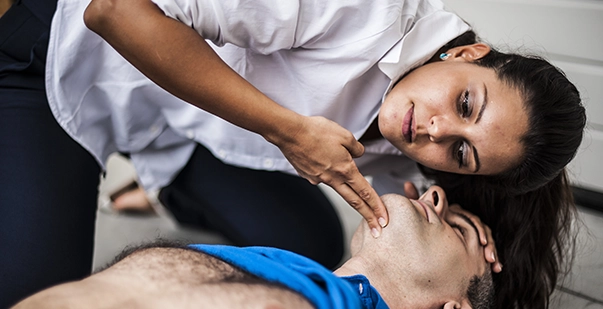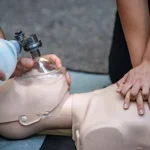When someone collapses, knowing the difference between respiratory arrest vs cardiac arrest can make all the difference. These two emergencies are often confused. Understanding the major differences is crucial for effective intervention. Respiratory arrest occurs when breathing stops, while cardiac arrest is when the heart ceases to function properly. Each condition requires a different approach to care and every second counts.
According to a 2023 study nearly 475,000 people die from cardiac arrest in the U.S. each year, while respiratory arrest often leads to cardiac arrest if untreated. Knowing the signs and acting fast can prevent a tragic outcome.
So, what exactly sets these two emergencies apart, and how can you respond to each? Let’s dive into the key differences, the symptoms you need to watch for, and the life-saving steps. Whether you’re a healthcare professional or simply want to be prepared for an emergency, understanding these distinctions could one day help you save a life.
Everything One Needs To Know About Respiratory Arrest
When someone stops breathing, the situation becomes life-threatening in a matter of minutes. Respiratory arrest occurs when a person’s breathing completely ceases, leading to a lack of oxygen in the body. This condition can quickly progress to cardiac arrest if not treated immediately, making it essential to act fast.
What is Respiratory Arrest?
Respiratory arrest happens when the lungs stop functioning, and no air is being exchanged, cutting off oxygen to the body.
Common Causes:
- Airway obstruction (e.g., choking, swelling)
- Respiratory conditions like asthma or COPD
- Drug overdose, especially opioids
- Neurological conditions affecting breathing
Symptoms to Watch For:
- Sudden stop in breathing
- Blue or pale skin due to lack of oxygen
- Loss of consciousness
- Weak or absent pulse
Immediate Actions to Take:
- Call emergency services (911)
- Begin rescue breathing or CPR if trained
- Use an Automated External Defibrillator (AED) if available
Prevention Tips:
- Manage chronic respiratory conditions
- Avoid drug misuse
- Learn CPR and first aid skills
What Should You Know About Cardiac Arrest?
Cardiac arrest strikes without warning, and in an instant, the heart stops pumping blood, leaving the brain and vital organs starved of oxygen. It’s one of the most time-sensitive medical emergencies, and immediate action can be the difference between life and death.
What is Cardiac Arrest?
Cardiac arrest occurs when the heart suddenly stops beating, disrupting blood flow to the body’s organs.
Common Causes:
- Heart disease or heart attack
- Electrical disturbances in the heart (arrhythmias)
- Severe trauma or blood loss
- Drug overdose or drowning
Symptoms to Look For:
- Sudden collapse and unresponsiveness
- No pulse or signs of circulation
- Abnormal breathing or no breathing at all
- Loss of consciousness
Life-Saving Actions to Take:
- Call emergency services (911) immediately
- Begin CPR if trained, focusing on chest compressions
- Use an Automated External Defibrillator (AED) if available
Prevention Tips:
- Manage heart health with regular checkups
- Maintain a healthy lifestyle (diet, exercise)
- Learn CPR and how to use an AED
Core Differences Between Respiratory Vs Cardiac Arrest
Understanding the core differences between respiratory arrest and cardiac arrest is vital for responding appropriately in emergencies. While both conditions are life-threatening, they involve different processes in the body and require distinct interventions.
| Differences | Respiratory Arrest | Cardiac Arrest |
| Primary Cause | The lungs stop functioning, causing breathing to stop and oxygen levels to drop. | The heart stops beating or has an abnormal rhythm, preventing blood flow to vital organs. |
| Main Symptoms | Absence of breathing, cyanosis (blue or pale skin), loss of consciousness. | No pulse, sudden collapse, unresponsiveness, abnormal or no breathing. |
| Immediate Effect | Lack of oxygen to the blood, which may lead to cardiac arrest if untreated. | The heart cannot pump blood, causing organs, including the brain, to fail rapidly. |
| Treatment Approach | Rescue breathing and maintaining an open airway are critical. | Immediate CPR and defibrillation (AED) to restore the heart’s function. |
| Outcome Without Intervention | Leads to cardiac arrest if not treated. | Fatal within minutes without CPR or AED use. |
Prevention Tips for Cardiac & Respiratory Arrest
Preventing life-threatening emergencies like cardiac and respiratory arrest starts with taking proactive steps to protect your health. While some risk factors are out of our control, adopting healthy habits can significantly reduce the chances of these critical events. Here are practical tips to help prevent both cardiac and respiratory arrest.
For Cardiac Arrest:
- Maintain a Heart-Healthy Diet: Focus on a balanced diet rich in fruits, vegetables, lean proteins, and whole grains.
- Exercise Regularly: Aim for at least 150 minutes of moderate aerobic activity each week.
- Manage Blood Pressure and Cholesterol: Regular checkups can help keep these key heart health indicators in check.
- Avoid Smoking and Excessive Alcohol: Both habits increase the risk of heart disease and cardiac arrest.
- Know Your Family History: If heart disease runs in your family, take preventive action with your healthcare provider.
For Respiratory Arrest:
- Avoid Smoking: Smoking is a leading cause of lung diseases that can lead to respiratory arrest.
- Manage Respiratory Conditions: Stay on top of medications and treatment plans for asthma, COPD, and other respiratory issues.
- Prevent Infections: Regular hand washing and vaccinations can help prevent respiratory infections like pneumonia.
- Avoid Drug Misuse: Especially with opioids, which can lead to respiratory depression and arrest.
- Monitor Airway Obstructions: Be cautious with food or objects that could cause choking, especially in children.
When Respiratory Arrest Leads to Cardiac Arrest
Respiratory arrest and cardiac arrest are closely linked. In many cases, untreated respiratory arrest can quickly progress to cardiac arrest. When breathing stops, oxygen levels in the body rises. Without immediate intervention, the heart will eventually stop as well.
Times when respiratory arrest inclines towards a cardiac attack-
- Lack of Oxygen Supply: When the lungs fail to deliver oxygen to the blood, the brain and organs are deprived of oxygen, which can lead to cardiac failure within minutes.
- Progressive Heart Strain: The heart tries to compensate for the lack of oxygen by working harder, but without proper oxygenation, it eventually weakens and stops.
- Time Sensitivity: Without intervention, cardiac arrest typically follows respiratory arrest within minutes. Quick action is essential to restore breathing and prevent heart failure.
Training and Skills Needed to Respond to Both Conditions
Effective response to emergencies like cardiac and respiratory arrest requires specific training and skills. Being prepared to act swiftly and accurately can significantly improve outcomes and save lives.
Basic Life Support (BLS) Certification:
- Includes CPR (Cardiopulmonary Resuscitation) techniques, rescue breathing, and AED (Automated External Defibrillator) use.
- Teaches foundational skills needed to respond to both cardiac and respiratory arrest.
Advanced Cardiovascular Life Support (ACLS):
- Advanced techniques for managing cardiac arrest, including medication administration, advanced airway management, and rhythm analysis.
- Prepares healthcare professionals to handle complex cases and manage severe cardiac emergencies.
First Aid Training:
- Basic skills for handling various emergencies, including choking, unconsciousness, and breathing difficulties.
- Provides knowledge on immediate actions to take while waiting for emergency services.
Choking Relief Techniques:
- Procedures for clearing an obstructed airway in both adults and children.
- Essential for preventing respiratory arrest due to choking.
Use of Automated External Defibrillators (AEDs):
- How to properly use an AED to deliver electrical shocks to restore a normal heart rhythm.
- Vital for responding to cardiac arrest and improving survival rates.
Continuous Practice and Refresher Courses:
- Regular updates and practice of life-saving techniques to stay current with best practices.
- Ensures skills remain sharp and effective in high-pressure situations
Conclusion
Understanding respiratory arrest vs cardiac arrest ensures effective response during emergencies. While both of these conditions are life threatening, they require different approaches. Recognizing these signs along with differences significantly impacts patient outcomes. As respiratory arrests quickly progresses into a cardiac attack, prompt action is a must. So equip yourself with the right knowledge and handle these situations with confidence. Enroll in an Advanced Cardiovascular Life Support course to get a thorough understanding on the management of these two potentially fatal conditions.
Read More: Mastering High Quality CPR: Essential Techniques and Tips
Read More: Warning signs of stroke: Early detection saves lives





